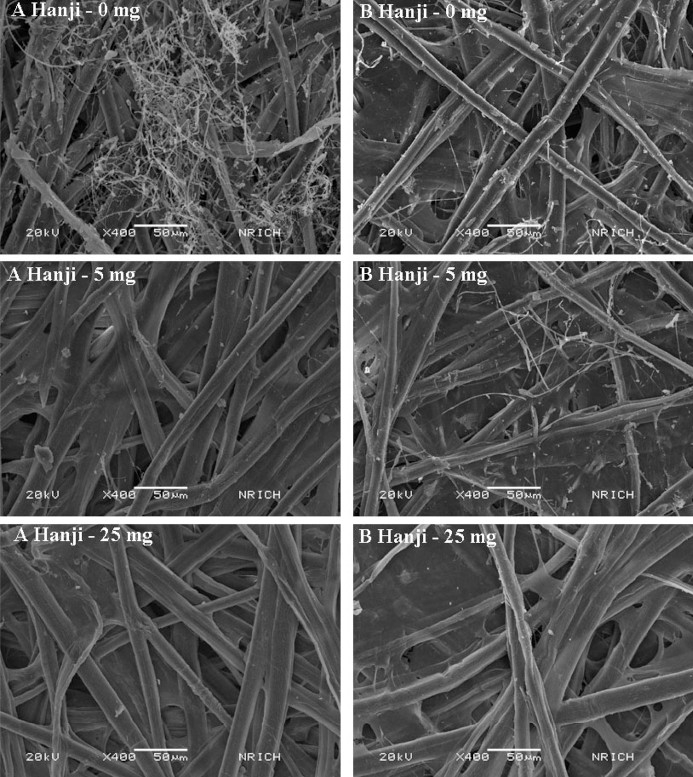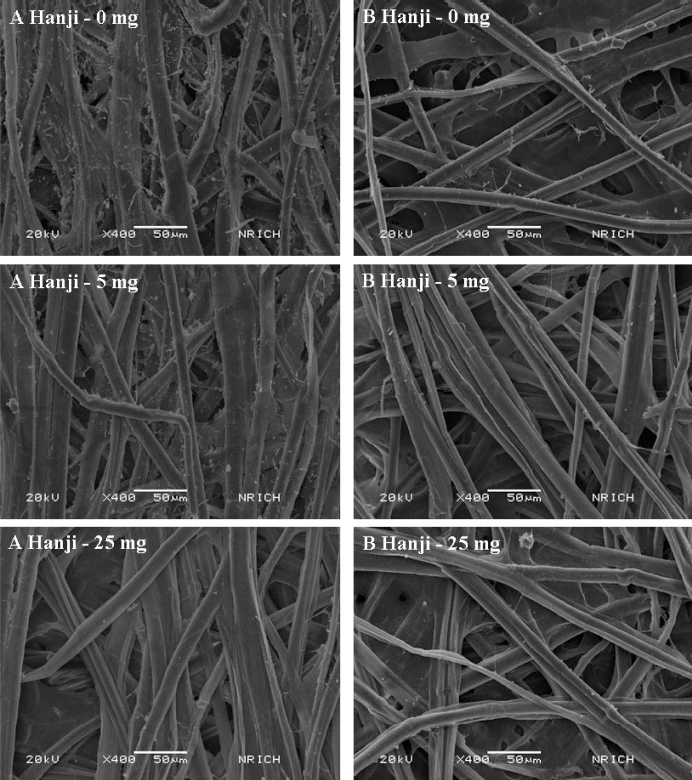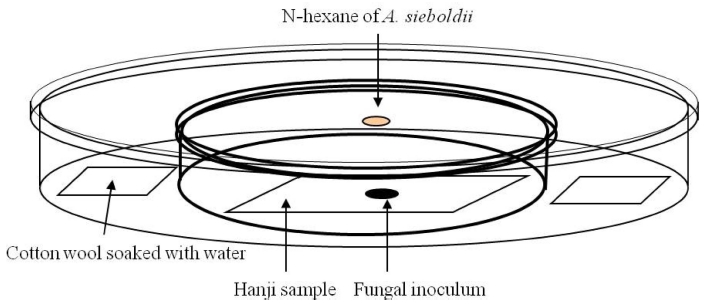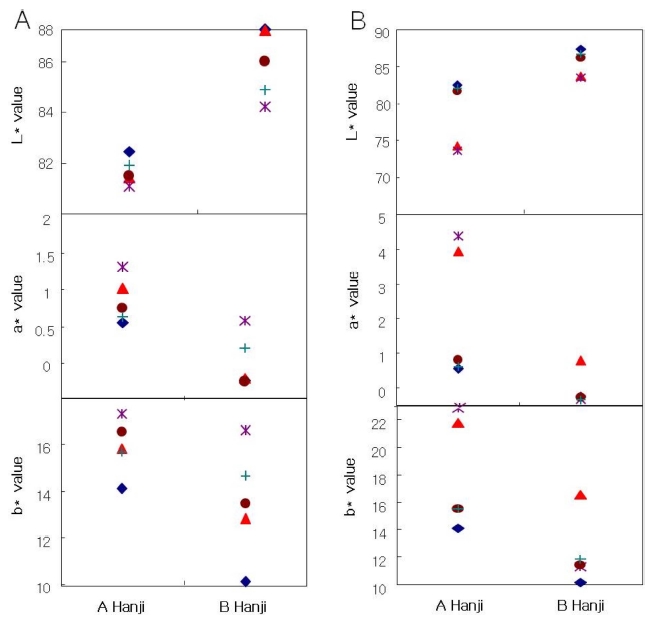
Inhibitory Activity of Asarum sieboldii against Wood Rot Fungi on Traditional Paper, Hanji
© The Korean Society of Medicinal Crop Science. All rights reserved.
This is an Open-Access article distributed under the terms of the Creative Commons Attribution Non-Commercial License ( http://creativecommons.org/licenses/by-nc/3.0 ) which permits unrestricted non-commercial use, distribution, and reproduction in any medium, provided the original work is properly cited.
Abstract
To investigate the possibility of using Asarum sieboldii as an environment-friendly fumigant for protecting organic cultural heritages, the inhibitory effect of A. sieboldii extract against wood rot fungi on Hanji was examined.
The physical, optical, and morphological properties of Hanji inoculated with Trametes versicolor and Tyromyces palustris, and exposed to the n-hexane fraction of A. sieboldii extract, were measured. The physical properties were expressed as weight loss, zero-span tensile strength and viscosity and the optical properties were depicted by luminance and chromaticity (L*, a*, and b*). The results showed that, the n-hexane fraction of A. sieboldii extract inhibited the growth of fungi on Hanji, and preserved its condition. At a concentration of 25 ㎎, the n-hexane fraction of A. sieboldii extract maintained zero-span tensile strength, increased viscosity, and restricted discoloration of Hanji. It also was confirmed that the weight of fungi infested Hanji exposed to the extract did not decrease. Scanning electron microscopic images revealed that the spores and hyphae of T. versicolor and T. palustris were not present on Hanji during treatment with > 25 ㎎ of the n-hexane fraction of A. sieboldii extract.
These results indicate that the n-hexane fraction of A. sieboldii extract by virtue of its antifungal effectiveness may help in preserving Korean paper cultural heritages, including Hanji.
Keywords:
Asarum sieboldii, Trametes versicolor, Tyromyces palustris, HanjiINTRODUCTION
Paper artifacts kept in museums and libraries are susceptible to biological damage caused by insects and microorganisms. In particular, components of paper such as cellulose, lignin, hemicellulose, pectins, various types of wax, tannins, and proteins are nutrients used by microorganisms (Kowalik, 1980). Fungi secrete hydrolytic enzymes and organic acids that facilitate deterioration and decomposition of paper.
In Korea, there are many paper artifacts made from Hanji, which is a traditional Korean paper handmade from mulberry trees (NRICH, 2013). Fumigants such as methyl bromide and ethylene oxide have been used to control the biodeterioration caused by fungi (Mabuchi et al., 2003). However, these chemicals can damage valuable Hanji artifacts by exfoliating pigments and paint and changing the ash content. In addition, they are a risk to human health. Therefore, demands for biocontrol derived from natural sources have increased recently. According to the results from our previous biocide screening assay, we found that Asarum sieboldii root extract is effective for controlling biodeteriogens (Lim et al., 2008; Kang et al., 2012).
A. sieboldii is widely distributed in the southern part of Korea and has a characteristic odor and a spicy taste that paralyzes the tongue (Zhu, 1998). Root extracts of A. sieboldii have fever, sedation, analgesia, local anesthetic, ant-inflammatory, immuno suppressive, and allergic effects, as well as antimicrobial activity (Lee et al., 2005; Hashimoto et al., 1994; Han et al., 2006; Kang et al., 2012). A few studies in pharmacology discipline showed that A. sieboldii essential oil has strong antifungal and antibacterial effects against various species (Yu et al., 2007). These studies revealed that A. sieboldii contains methyleugenol (42.2%), safrole (12.0%) and euvarvone (9.8%) (Yao et al., 1981), and among these components, methyleugenol and safrole show high insecticidal activities against Lasioderma serricorne L (Kang et al., 2012). These findings support the speculation made in this study that A. sieboldii extracts may be an effective natural fumigant for organic cultural heritages made of fabric, paper, and wood.
The aim of this study was to examine the potential inhibitory effects of A. sieboldii extract against biodeteriogens to preserve paper artifacts. In addition, we investigated the physical and optical characteristics and scanning electron microscopic (SEM) images of Hanji exposed to A. sieboldii extract.
MATERIALS AND METHODS
1. Preparation of Hanji
Hanji produced by a company using the traditional methods were used. These Hanji samples were made from raw materials including a bast fiber of paper mulberry as a fiber resource, the natural ash of plant stems as pulping chemicals and ‘Dakpool’ as dispersants. The basic information of the Hanji samples is summarized in Table 1.
Two types of Hanji (types A and B), made using traditional techniques from different parts of Korea, were used. Each Hanji specimen was 60 × 60㎜ of size, autoclaved at 121℃ for 15 min, and then dried at room temperature.
2. Asarum sieboldii extracts
Dried A. sieboldii was purchased from Jaecheon herbs Co (Jaecheon, Korea). The roots containing the medicinal ingredient were extracted with 99% methanol and filtered. All filtrates were concentrated at 35℃. The methanol extract was fractionated with n-hexane and concentrated using a vacuum evaporator (EYELA, Tokyo, Japan). To investigate the antifungal effectiveness of different concentration (0 - 40㎎) of A. sieboldii extract (ASE) treated to the Hanji samples, 0.1, 0.5 and 0.8 g·㎖−1 of the n-hexane fraction (HXF) dissolved in ethanol were prepared and n-hexane fractions of 50㎕ were absorbed in paper disc.
3. Fungal strains and Inoculation
Trametes versicolor (KFRI 20256), a white rot, and Tyromyces palustris (KFRI 21055), a brown rot, being capable of degrading cellulose, were used in the biodeterioration assay (Kim et al., 2002; Shimada et al., 1994). The two fungi were provided by the Forest Engineering Department of Chungnam University. The strains had been maintained on potato dextrose agar (PDA, Difco, Becton, Dickinson and Co., Franklin Lakes, NJ, USA).
The Hanji samples were inoculated with T. versicolor and T. palustris. For each experiment, the Hanji sample was placed in a small petri dish and a paper disc dipped with each dose of the ASE-HXF was attached to the inside of the lid of the same petri dish. The Hanji was inoculated with a fungal block obtained from mycelia on PDA at the middle of the Hanji sample. The 90 × 15㎜ petri dish was placed in 150 × 25㎜ petri dish. As humidity is an important factor influencing fungal growth, sterilized cotton wool dipped in a sterilized distilled water was used to increase relative humidity (Fig. 1). All procedures were performed stimultaneously at once. The test petri dishes were hermetically sealed and incubated at 28℃ for 30 days. After exposing the Hanji samples to the vapor of each dose of n-hexane, the Hanji sample was removed from the test petri dish. The mycelia were carefully brushed off the samples and then, Hanji samples were used in various analysis.
4. Damage assessment of the Hanji
To evaluate the physical and optical changes, weight loss, zero-span tensile strength [TAPPI (Technical Association of the Pulp and Paper Industry) Method T 231], viscosity degree of cellulose (TAPPI Method T230 om-99 and T254) and luminance and chromaticity (lightness, redness, yellowness) (ISO 5631) were measured. These parameters allowed us to evaluate the degradation state of the Hanji. The statistical analysis on physical properties test was obtained by One-way analysis of variance (ANOVA) using excel software (Microsoft, Redmond, WA, USA). p < 0.05 were considered as statistical significance.
Weight loss (%) was calculated from the conditioned weight of Hanji sample immediately before and after testing as follows: weight loss (%) = (T3- T4)/T3× 100. Where T3 is the weight of the Hanji sample plus the remaining preservative after conditioning but before exposure to the test fungi (g), and T4 is the weight of the Hanji sample after testing and final conditioning (g).
Zero-span tensile strength of each paper sample, which is one of the major paper strengths, was measured using a universal testing machine (Zero span-1000, Pulmac Inc., Montreal, Canada) based on TAPPI T231. A load was applied at a span length as close to zero as possible in order to achieve the measurements with high precision. Referring to TAPPI T231 standard methods, all paper samples for these zero-span tensile strength analysis were re-conditioned to 23℃ of air temperature and 50% of relative humidity for 24 hours.
It is known that the degradation of cellulose leads to the decrease of viscosity and subsequently the decrease of paper durability (Jablonský et al., 2011; Zou et al., 1996). This allowed us to indirectly estimate the degree of degradation of each paper sample-associated with their durability. The viscosity of paper estimated a popular method based on TAPPI standard method T230. However, the molecular weight of bast fiber of paper mulberry is the major resource of Hanji is significantly higher than that of wood fiber. Thus, that of Hanji was estimated using T254 following as: 0.0625 g of an air-dried Hanji sample was put into an Erlenmeyer flask of 100 ㎖ with 6 ㎜ of several glass beads, and 15 ㎖ of 0.167 M cupriethylene diamine (CED) solution was added to the sample. Then, the sample was purged with nitrogen for 1 min in order to prevent the degradation of cellulose. A cap of the flask was quickly screwed and the mixture was stirred for 20 min using a stirrer rotating at approximately 200 rpm. After these treatment procedures, another 10 ㎖ of 1M CED solution was added to the sample and then the sample was purged with nitrogen for another 1 min. Once again, the cap of the flask was quickly screwed and stir was solved samples was placed in a water bath at 25℃ of temperature for 5 min. Finally, the viscosity for each sample was calculated by measuring the efflux time for drawing the solution.
To measure the optical properties of the paper, Hanji samples were re-conditioned to 23℃ of air temperature and 50% of relative humidity for 24 hours. The optical properties were measured using a spectrophotometer (ELREPHO, Lorentzen and Wettre, Kista, Sweden) based on ISO standard methods 5631 and 2470.
The morphology of the fungus on the Hanji was observed by the JEOL-JSM 5910 LV (JEOL Ltd., Tokyo, Japan). Each specimen was sampled at an approximate size of 10 × 5㎜, mounted on stubs, and coated with gold to prevent electrostatic charge from accumulating on the surface and to increase the signal. A 15.0 kV accelerating voltage was used for SEM.
RESULTS AND DISCUSSION
1. Effects of A. sieboldii extracts on the physical and optical properties of Hanji
The weight losses of Hanji attacked by wood rot fungi were investigated. Weight loss (%) caused by the two fungi after 4 weeks is presented in Fig. 2. The weight change of paper indicates the decomposition of cellulose. The type A Hanji samples were severely attacked by T. versicolor and T. palustris with 22.08% and 26.45% weight losses, respectively. Additionally, T. plaustris caused larger weight losses than those of T. versicolor. The type B Hanji samples had a slight damage by T. versicolor and T. palustris with 5.33% and 4.09% weight loss, respectively. It was considered that different of weight loss between A and B type Hanji was due to difference of cooking chemicals or in manufacturing method of artisan. For that reason, A and B type Hanji are different in basic weight (g/㎡), lignin content, viscosity and so on. However, the weight losses of Hanji samples exposed to > 25㎎ of the HXF decreased drastically. Consequentially, the ASE-HXF prevented attack by wood rot fungi on Hanji.

Weight loss (%) of Hanji A and B treated with ASE-HXF (n-hexane fraction from A. sieboldii extract).T. versicolor and T. palustris were used as the source of biodegradation.
Similar to the case of weight loss, the loss in strength has been long known to be affected by the depolymerization of cellulose (Corbett and Richards, 1957; Suckling et al., 2001). Fig. 3 demonstrates change of decreasing rate (%) in zero-span tensile strength of Hanji samples with respect to treatment of different amounts of ASE and exposure of wood rot fungi, simultaneously.

Decreasing rate (%) of zero-span tensile strength of Hanji A and B treated with ASE-HXF (n-hexane fraction from A. sieboldii extract).T. versicolor and T. palustris were used as the source of biodegradation.
The graph shows that the zero-span tensile strength of both A and B Hanji samples noticeably decreased for the attack of wood rot fungi, especially T. palustris. T. palustris weakened strength of A Hanji by 90.8% and B Hanji by 77.8%. After exposure to 5㎎ of ASE-HXF, zero-span tensile strength of A and B Hanji weakened by T. palustris was increased by 9.04% and 61.7%. The ASE-HXF of 25㎎ significantly increased zero-span tensile strength.
Finally, the viscosity was measured to determine the average molecular weight of the cellulose fiber, which is a major component in paper. Numerous properties of papers are related to the molecular mass of their main constituent, cellulose (Ucar and Balaban, 2004). By defining the viscosity value of the Hanji deteriorated by T. versicolor and T. palustris respectively as 1.00, the viscosity of Hanji exposed to various doses of the ASEHXF were converted and compared. Fig. 4 shows a increment of the viscosity as the amount of ASE-HXF treated to the Hanji samples. The viscosity of the types A and B Hanji increased slightly by 19.15 and 5.60 fold at a dose of 5㎎, compared to the Hanji deteriorated by T. versicolor (Fig. 4). However, the viscosities of the type A and B Hanji increased by 315.58 and 23.94 fold at a HXF dose of 25㎎. The Hanji deteriorated by T. palustris had drastically reduced viscosity, due to the degradation of the cellulose in Hanji. The viscosity of the type A and B Hanji increased slightly by 0.34 and 3,766.1 fold at a dose of 5㎎ of the HXF, compared to that of Hanji deteriorated by T. palustris and untreated. The viscosities of the type A and B Hanji samples increased sharply by 15,026.1 and 11,647.1 fold at a dose of 25㎎ of the HXF.

Changes in viscosity of Hanji A and B treated with ASE-HXF (n-hexane fraction from A. sieboldii extract).T. versicolor and T. palustris were used as the source of biodegradation. The concentration 0 ㎎ sample was used as a control (1.00).
Similar to the case of zero-span tensile strength, the viscosity of Hanji samples treated with extracts show increasing patterns as the treated amount of ASE-HXF increase from 0 to 25㎎. At 40㎎, however, the reversed patterns are observed in both 2 types of Hanji samples.
Overall, the weight, zero-span tensile strength and viscosity of the Hanji decreased and changed due to growth of the fungi, but ASE-HXF maintained the original condition of the Hanji by inhibiting effectively the growth of fungi.
The luminance and chromaticity of Hanji was determined by the light adsorbance of the constituents. Growth of T. versicolor and T. palustris on Hanji decreased the L* value and increased the a* and b* values of Hanji. The L* value indicates the degree of white (100) or black color (0). The increase in the a* and b* values indicates red and yellow colors, respectively. The hyphae, spores, and metabolites produced by the fungi influenced the optical properties. T. palustris caused greater changes in the color of the Hanji than that of T. versicolor. Hanji samples treated with T. versicolor recovered to control levels when exposed to the ASEHXF (Fig. 5).
2. Antifungal activities of A. sieboldii extracts on the surface of Hanji
Antifungal activities of ASE-HXF were examined through the comparisons of microphotographs. As shown in Fig. 6 and 7, the Hanji before exposure to the extract was crowded with spores and hyphae of T. versicolor and T. palustris. The fibers of the Hanji deteriorated by T. versicolor and T. palustris were degraded and broken. There were many by-products and hyphae from T. versicolor and T. palustris that adhered to the surface of the Hanji fibers. The Hanji fiber has a unique wave pattern, which disappeared after invasion by T. versicolor and T. palustris.

SEM imagery showing changes in biologically-aged Hanji by T. versicolor after different amount of ASE-HXF (n-hexane fraction from A. sieboldii extract) are treated to Hanji sample on.

SEM imagery showing changes in biologically-aged Hanji by T. palustris after different amount of ASE-HXF (n-hexane fraction from A. sieboldii extract) are treated to Hanji sample on.
Dakpool is the alkaline mucilage that oozes from the roots of Hibiscus manihot and helps to float and disperse the individual fibers in the pulp slurry, to separate the wet paper easily while stacked, and to form a flat web by delaying water drainage through the web screen. “Dakpool” broadly filled in the fiber network of the paper without fungi. The dakpool was partially degraded in the Hanji treated with T. versicolor and T. palustris. Dakpool, which contain saccharides such as d-glucose, l-arabinose, lrhamnose, xylose, and glucose is easily attacked by microorganisms. However, at an extract dose of ≥ 25㎎, the spores and hyphae of T. versicolor and T. palustris were not observed, and the Hanji fibers remained intact. Kim et al. (2015) have reported that Asasum sieboldii inhibited growth of fungus, Aspergillus versicolor on the surface of the Hanji in study for artificial aging of Hanji.
Overall, the ASE-HXF was capable of inhibiting spore germination and growth of these rot fungi on two types of Hanji for 4 weeks at 28℃ and 100% relative humidity. With these results that physical and optical properties of Hanji were preserved.
In conclusion, the possibility of ASE as effective antifungal agent for Hanji is confirmed. This study suggests that ASE can be the potential as natural biocide for paper cultural heritages mostly Hanji
ACKNOWLEDGMENTS
This study was supported by the Convergence Research Project on Cultural Heritage, through the National Research Institute of Cultural Heritage (NRICH) in the Republic Korea.
References
- Corbett, WM, Richards, GN, The degradation of cellulose by aqueous sodium hydroxide at 170℃, Svensk Papperstidn, (1957), 60, p791-794.
- Han, SH, Woo, NRY, Lee, SD, Kang, MH, Antioxidative and antibacterial activities of endemic plants extracts in Korea, Korean Journal of Medicinal Crop Science, (2006), 14, p49-55.
-
Hashimoto, K, Yanagisawa, T, Okui, Y, Ikeya, Y, Maruno, M, Fujita, T, Studies on anti-allergic components in the roots of Asiasarum sieboldi, Planta Medica, (1994), 60, p124-127.
[https://doi.org/10.1055/s-2006-959432]

- Jablonský, M, Katuš?ák, S, Ka?ik, F, Ka?iková, D, Changes in newsprint paper during accelerated ageing, Cellulose Chemistry and Technology, (2011), 45, p405-411.
-
Kang, SY, Chung, YJ, Lim, JA, Antifungal and insecticidal activity of essential oil from Asarum sieboldii against wood contaminant fungi and Lasioderma serricorne L, Journal of Conservation Science, (2012), 28, p395-401.
[https://doi.org/10.12654/jcs.2012.28.4.395]

-
Kim, KS, Leem, YE, Kim, KJ, Kim, KH, Choi, HT, Transformation of the medicinal basidiomycete Trametes versicolor to hygromycin B resistance by restriction enzyme mediated integration, FEMS Microbiology Letters, (2002), 209, p273-276.
[https://doi.org/10.1016/s0378-1097(02)00555-4]

-
Kim, YH, Hong, JY, Jo, CW, Kim, SJ, Lee, JM, Choi, KH, Effects of Asarum sieboldii miquel extracts on the properties of Korean traditional paper (Hanji), Journal of Cultural Heritage, (2015), 16, p890-895.
[https://doi.org/10.1016/j.culher.2015.02.004]

- Kowalik, R, Microbiodeterioration of library materials, Part 1. Restaurator, (1980), 4, p99-114.
-
Lee, JY, Moon, SS, Hwang, BK, Isolation and antifungal activity of kakuol, a propiophenone derivative from Asarum sieboldii rhizome, Pest Management Science, (2005), 61, p821-825.
[https://doi.org/10.1002/ps.1050]

- Lim, JA, Choi, YA, Jung, MH, Kang, SY, Chung, YJ, Antifungal and insecticidal activity of methanol extracts from 17 medicinal plants against bioligical deterioration of organic cultural heritage, Conservation Studies, (2008), 29, p126-136.
- National Research Institute of Cultural Heritage(NRICH), Reviving the annals of Joseon Dynasty, (2013), National Research Institute of Cultural Heritage, Daejeon, Korea, p31-32.
-
Shimada, M, Ma, DB, Akamatsu, Y, Hattori, T, A proposed role of oxalic acid in wood decay systems of woodrotting basidiomycetes, FEMS Microbiology Reviews, (1994), 13, p285-295.
[https://doi.org/10.1016/0168-6445(94)90086-8]

- Suckling, ID, Allison, RW, Campion, SH, McGrouther, KG, McDonald, AG, Monitoring cellulose degradation during conventional and modified kraft pulping, Journal of Pulp and Paper Science, (2001), 27, p336-341.
- Uçar, G, Balaban, M, Accurate determination of the limiting viscosity number of pulps, Wood Science and Technology, (2004), 38, p139-148.
- Yao, SC, Wang, LL, Yeung, CS, Pharmacology and applications of Chinese materia medica, (1981), World Scientific, Beijing, China, p838-840.
- Yu, HH, Seo, SJ, Hur, JM, Lee, HS, Lee, YE, You, YO, Asarum sieboldii extracts attenuate growth, acid production, adhesion, and water-insoluble glucan synthesis of Streptococcus mutans, Journal of Medicinal Food, (2007), 9, p505-509.
- Zhu, YP, Chinese materia medica Chemistry, pharmacology, and applications, (1998), Harwood Academic Publishers, Amsterdam, Netherlands, p66-68.
-
Zou, X, Uesaka, T, Gurnagul, N, Prediction of paper permanence by accelerated aging I Kinetic analysis of the aging process, Cellulose, (1996), 3, p243-267.
[https://doi.org/10.1007/bf02228805]



